Why Most SEO Production Agencies Fail to Deliver Results Fast Enough (With Process Diagram)
by
Jeremy Tang - Updated
24-Sep-2024
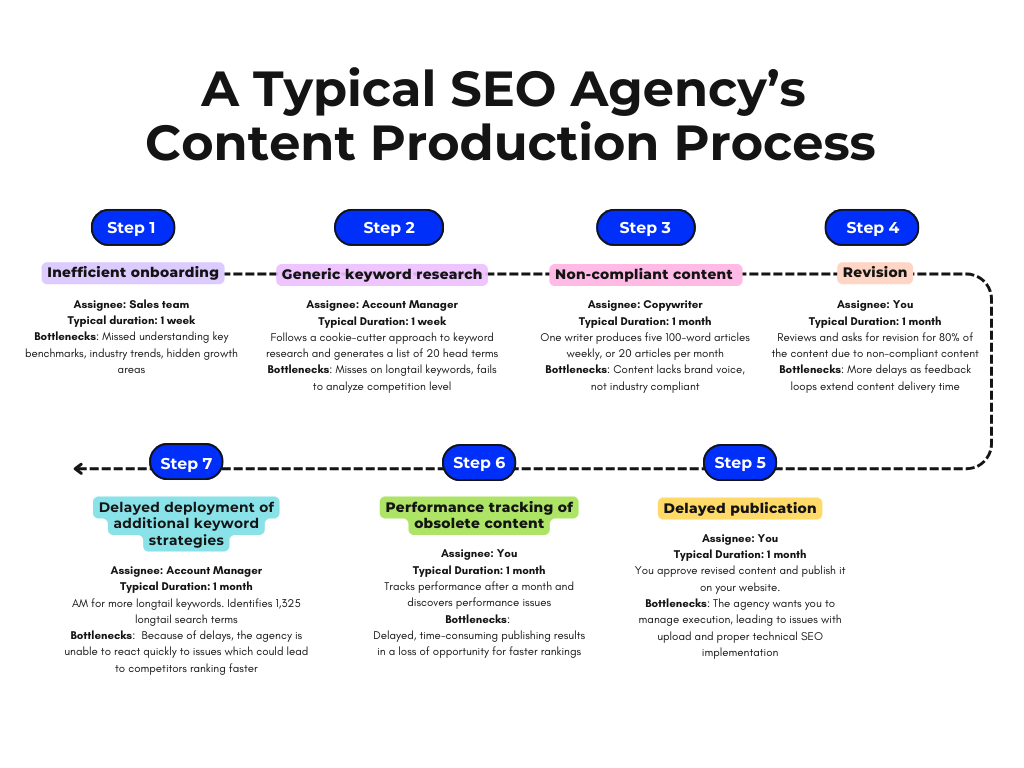
Most SEO production agencies struggle to deliver fast results due to slow workflows, inefficient processes, and a lack of scalable content production. Area Ten addresses these issues by leveraging automation and AI-powered tools, providing high-quality, SEO-optimized content at 4x the speed of traditional agencies.
As online competition continues to heat up, more businesses are starting to realize the value of partnering with an effective search engine optimization (SEO) production agency.
How is an SEO production agency different from the typical agency, you ask? Essentially, these types of companies excel at creating and scaling high-quality, SEO-optimized content.
Think of an SEO production agency as a high-speed content factory. While consultants are like architects who plan and design your SEO strategy, SEO production agencies are the builders who bring those plans to life. They’re all about cranking out high-quality, SEO-optimized content that answers every question your audience asks online.
Anyone who wants to make it big in SEO might already be familiar with the phrase “content is king.”
This phrase was coined in the 1990s, but it still rings very true to this day. However, not everything has stayed the same—with the Internet being much more prominent today, it’s the combination of content quality and scalability that truly reigns supreme.
If your business aims to dominate search engine results and attract a steady stream of organic traffic, having a good SEO production agency by your side is indispensable. They keep the content coming, making sure it’s optimized to meet both search engine rules and what your audience actually wants.
Many SEO agencies are painfully slow.
The majority of agencies take up to six months to start delivering results, with a worrying percentage of them taking up to a year or even longer (Source: Ahrefs).
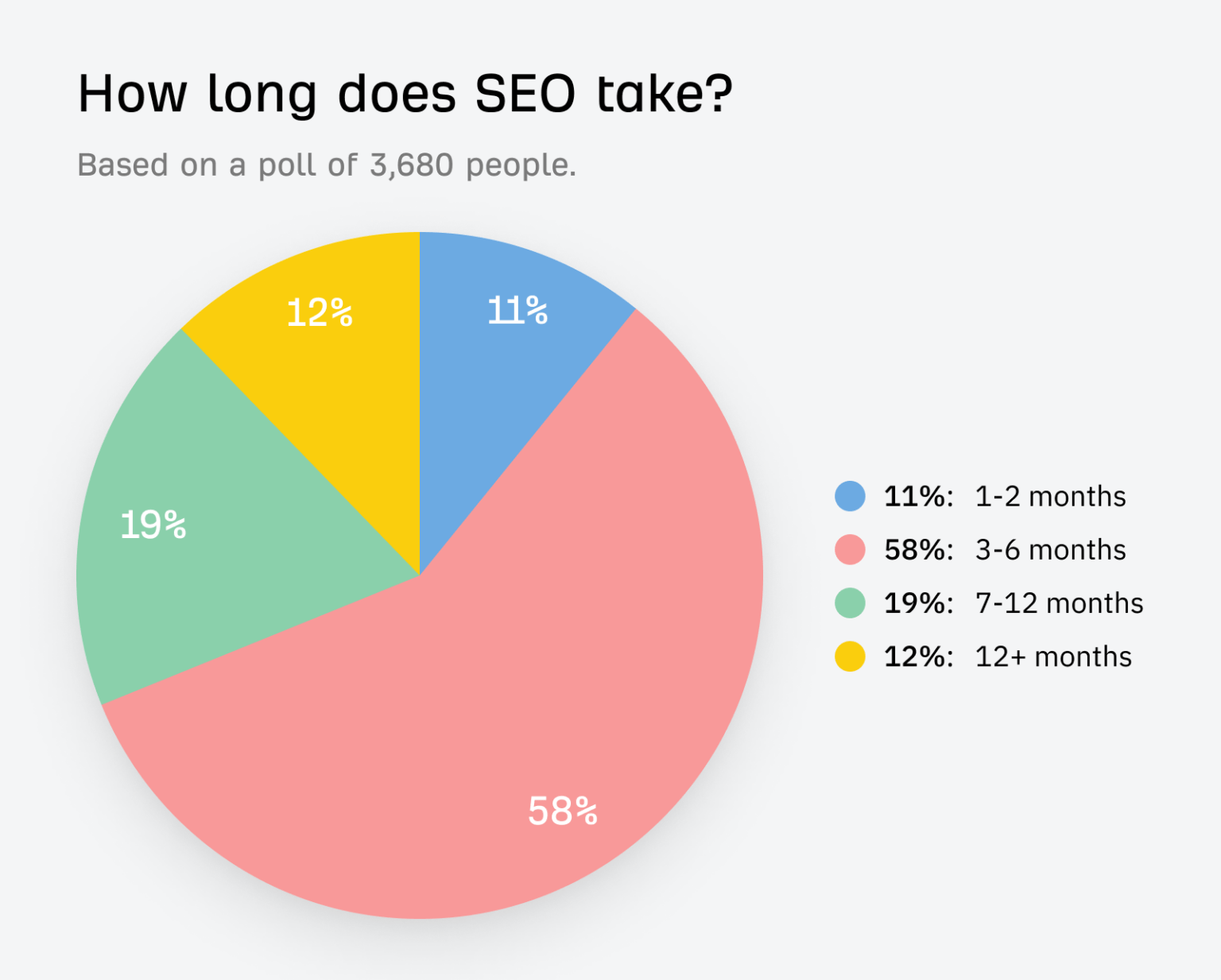
Source: Ahrefs
By the time your content goes live, you’ve already missed crucial windows for boosting your rankings or traffic growth. And the worst part is that the content that gets delivered won’t even be anything special.
That’s why, here at Area Ten, we’ve flipped the script on how content production should work, cutting out the roadblocks and streamlining the entire process.
Here are four reasons why most SEO production agencies fail to deliver results fast which we have avoided:
When teams like content creators, web developers, and marketing strategists are working in silos, things can get pretty messy.
It leads to poor communication, which slows everything down. Each group tends to focus on their own priorities and timelines, making it hard to stay on the same page. This lack of teamwork means important SEO tasks can get missed or duplicated, dragging out the whole process.
Ultimately, it stalls your SEO campaigns, leaving you with slower results than you’d like. That’s why having a unified, collaborative team is key to speeding things up and keeping things running smoothly.
The more people involved in the approval process, the slower things get.
Every step in SEO—whether it’s keyword research, content creation, optimization, or publishing—usually needs sign-offs from multiple people. Each stage of approval waits for someone to be available and give their input, and all these layers of review can seriously slow down the publication process. And when junior account managers have to pass feedback up the chain, things get even slower.
Making sure you get things done right is undoubtedly important, but if you start to overdo it, it can lead to some serious inefficiencies, which can hurt your search rankings. If you want to speed things up and capitalize on opportunities, you need to work with an agency that knows how to streamline its process.
Some SEO agencies hide behind long, convoluted workflows.
Instead of focusing on what really matters, they pile on extra steps, turning simple tasks into long, drawn-out processes. Before you know it, teams are stuck in endless meetings and approval loops, far from delivering any quick results. Instead of clear, actionable strategies, these agencies bury themselves in unnecessary layers of complexity.
The result? Delays, frustration, and clients left waiting.
A lot of SEO agencies tend to overlook easy wins that could give your rankings a quick boost. These include things like:
Instead of focusing on high-impact content opportunities, they spread themselves too thin, making tons of little optimizations that don’t add up fast. Because they lack a focused strategy, precious time is wasted on areas without immediate or measurable returns, delaying your overall progress and success.
Fun fact: 52 percent of business leaders make use of AI in their content development strategies (Source: Forbes).
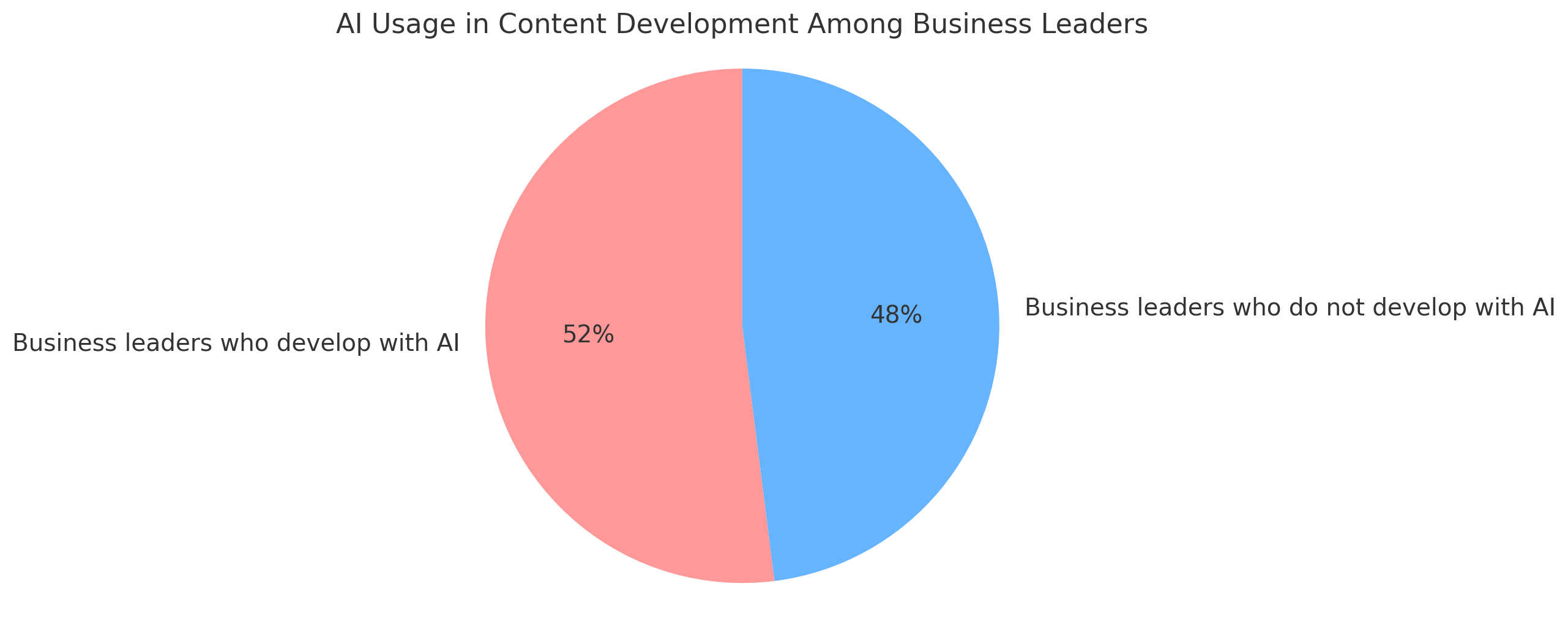
Source: Forbes
If you’re part of that 48 percent and are still hesitant about adopting this emerging technology, I seriously urge you to reconsider. Because the fact of the matter is, manual content creation simply can’t keep up with high-volume demands, especially if you run a large business.
A lot of agencies pour loads of time and resources into creating content around big “head terms.” These terms, while important for online visibility, are highly competitive and require extremely high-quality long-form content to rank. Sometimes they even require articles of more than 1,000 words.
Now, imagine having to do that for 100 different terms. That’s months of work before you can even start to see the light at the end of the tunnel. And after all that? The results don’t roll in right away, leaving you waiting with no quick wins in sight.
If you want to supercharge your content creation efforts, automation and programmatic SEO handled by a reputable corporate SEO agency are a must.
Here, you will want to focus on mid-level search terms and long-tail keywords to capture those niche audiences that your competitors likely aren’t even bothering with. Although handling content optimization and creation for thousands of keywords is a huge time drain, automation allows you to mass-produce content, all without breaking a sweat and burning through your resources.
One of the toughest things about scaling content through programmatic SEO is keeping your brand voice intact.
As content production ramps up, the risk of sounding generic skyrockets. A lot of the time, automated tools like ChatGPT or simple templates are used, which can lead to content that feels generic and bland.
Just look at the programmatic content in the gray box below built around the long-tail keyword “affordable eco-friendly yoga mats for beginners.” 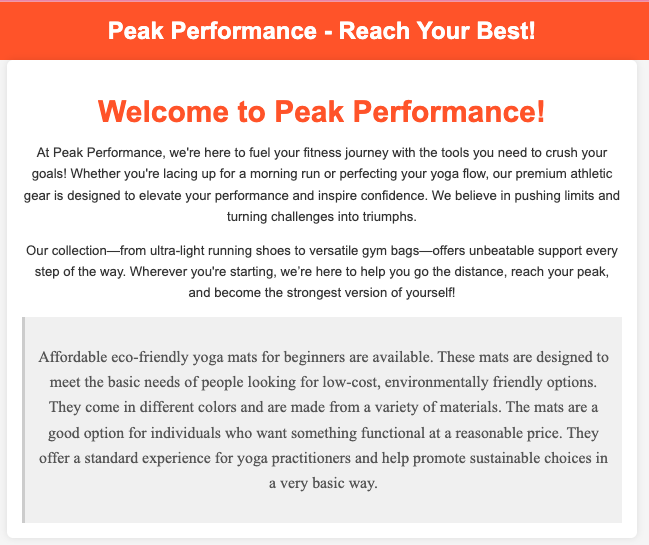
Sure, it gets the facts across, but where’s the brand’s spark or personality? It’s not enough to just be informative—you need to keep that personal touch that makes your brand stand out.
To scale without sacrificing the heart and soul of your brand, you’ve got to take a more thoughtful approach. Always practice due diligence and make sure you’re adopting automation tools and techniques that produce useful, quality content.
Staying on top of your SEO game is tough, especially with so many competitors chasing the same keywords.
But if you leverage the right AI-powered SEO tools, you can gain a competitive edge and make your job a lot easier. Take our CMAX platform at Area Ten, for example. It’s a programmatic SEO powerhouse designed to make a real difference by delivering fast and accurate results.
Instead of spending countless hours on manual optimizations, CMAX can automatically generate thousands of quality content pieces. And the best part? Each piece is tailored to your brand voice and adheres to industry compliance requirements, ensuring consistent quality at scale.
The automated cross-linking feature within CMAX is a game-changer.
Our proprietary technology allows you to optimize your website’s structure without having to lift a finger. That means you save time while keeping your site well-organized and search engine-friendly.
CMAX doesn’t just stop at performance analysis either. Using real-time data and SEO performance metrics, it adjusts your content dynamically, ensuring everything stays fresh and optimized.
Unlike SEO tools that need constant manual tweaking, CMAX evolves alongside search engine algorithms. Whenever there’s a change, it automatically makes the necessary adjustments to keep your content aligned with SEO best practices.
Plus, the tool’s cross-linking logic and swarm intelligence help improve underperforming pages by redistributing resources and fine-tuning internal links. This means your site not only stays balanced but continues to rank higher over time.
Ever wonder why so many providers of SEO services seem to take forever to deliver results?
A lot of it boils down to one thing: they’re not syncing up their SEO efforts with your overall marketing strategy. Picture this: your SEO team is busy optimizing content, while your marketing team is running paid ads with a completely different message. This all just leads to confusion, wasted time, and a frustratingly slow pace towards any sort of tangible outcome.
When SEO and marketing aren’t on the same page, everything drags. It’s like trying to drive a car with two people steering in opposite directions—you just end up spinning your wheels without getting anywhere.
If you want to see real progress, you need to find an SEO company that’s not afraid to collaborate and help you come up with a unified strategy.
One big mistake that happens a lot is chasing vanity metrics like traffic or keyword rankings without tying them to key business goals. Sure, those metrics look good on paper, but if they’re not helping your ROI (return on investment), then what’s the point?
For example, if your goal is to generate leads but your current SEO strategy is just driving irrelevant traffic, you’re just wasting time and effort. The key is making sure your SEO efforts are tied to real outcomes like conversions and revenue—not just rankings.
When your SEO services provider and marketing teams work together, everything just clicks, and the results come in way faster.
Imagine this: as soon as your SEO content is live, your paid ads and social media teams are ready to promote it instantly. No waiting around.
If you’ve just posted a new blog that’s optimized for SEO, why not have your social media and paid teams push it out on LinkedIn right away? You’ll see the impact a lot quicker.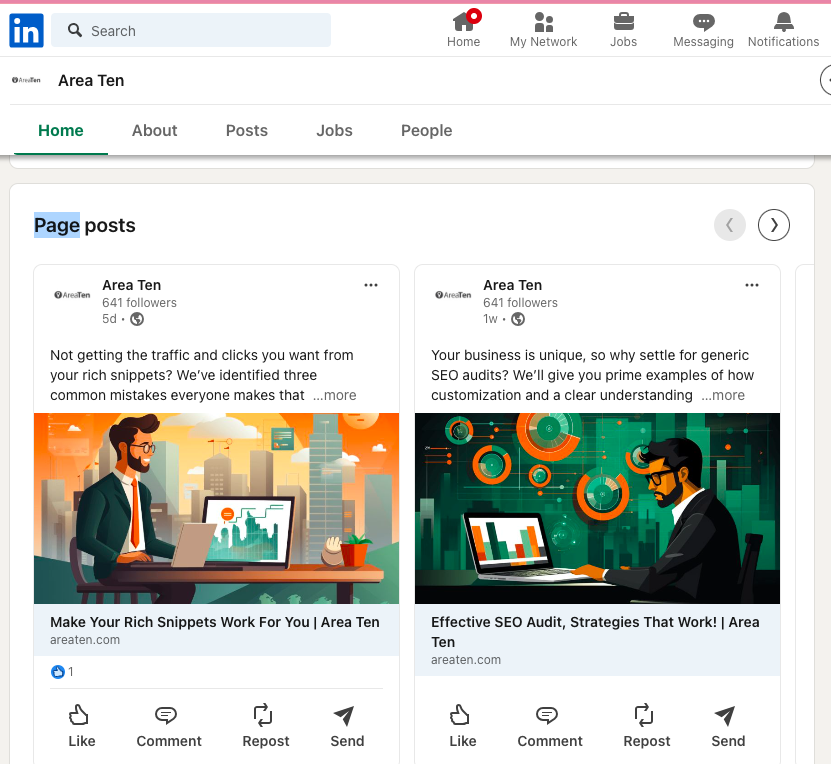
This type of synergy avoids the bottlenecks of disjointed teams, delivering quicker, more impactful outcomes.
According to surveys, 70 percent of marketers send out their SEO reports on a monthly basis (Source: Databox).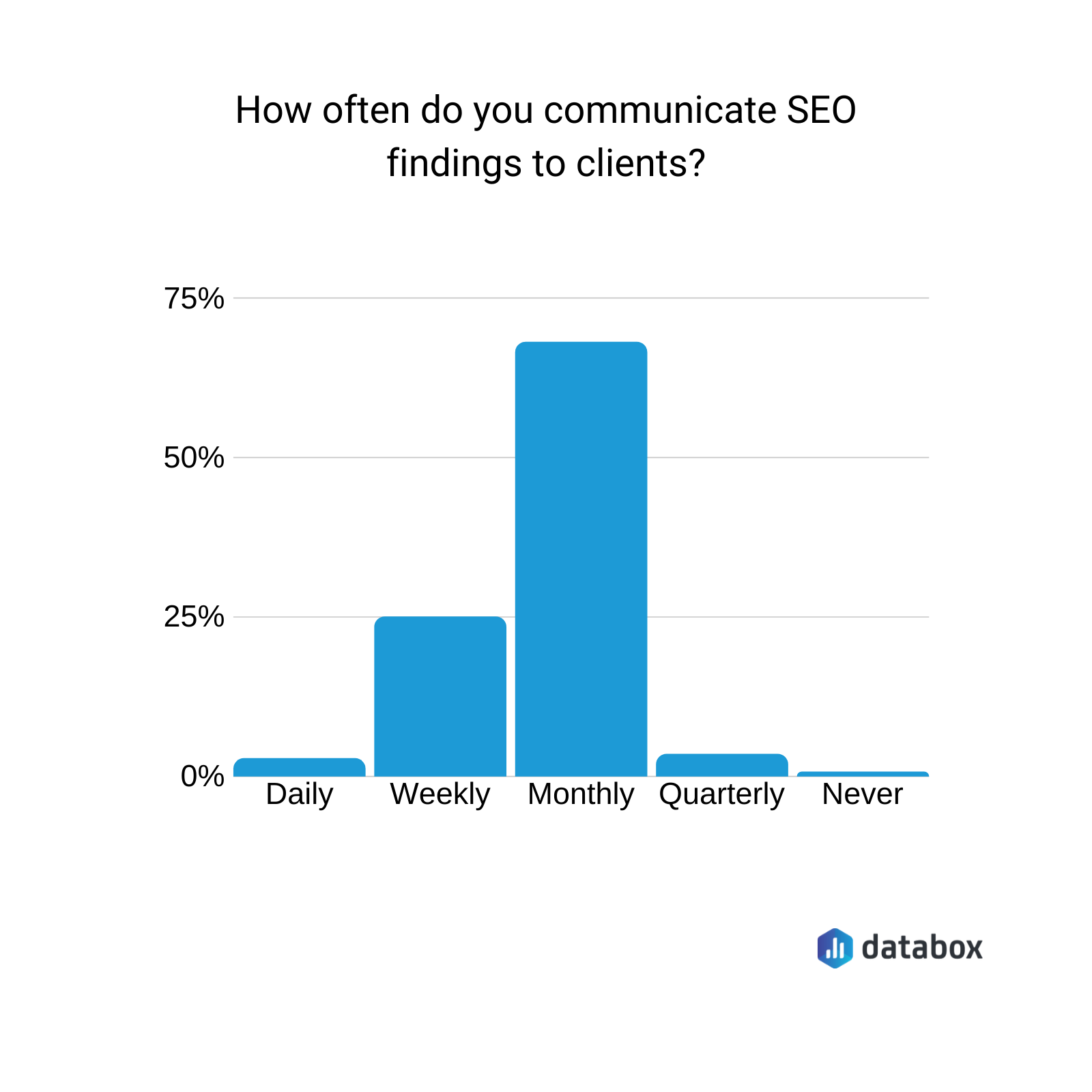
Source: Databox
There’s certainly a time and place for these types of reports, such as when you’re doing month-over-month comparisons. But when they’re all you rely on for data, it could be disastrous.
You see, monthly reports might seem like a great way to get in-depth insights on paper. But in practice, they can just slow you down.
By the time you catch a problem—whether it’s content that’s not performing or keyword trends shifting—you’re already weeks behind. This lag means you miss immediate opportunities for improvement, leaving your competitors with the upper hand.
Imagine spotting a rankings drop halfway through the month, but you’re stuck waiting for the next report to get the full picture before taking action. By then, your competition has already jumped in and taken advantage.
The faster you get insights, the quicker you can optimize.
Shorter feedback loops, such as weekly or real-time reporting, allow for more agile adjustments. Instead of waiting for a month to pass, you can make data-driven decisions within days.
If your new landing page isn’t performing as expected, for instance, you’ll know almost immediately and can make changes on the fly. This way, your traffic and rankings get a boost before your competitors even catch on.

The sales team initiates the process, but they will often lack a deep understanding of key benchmarks and industry trends.
If strategies aren’t tailored to fit the market and the client’s needs, the campaign might not have the best foundation. And once the first step is shaky, it can negatively affect the entire SEO process down the line.
Once that’s done, the account manager typically zeroes in on a narrow set of broad head terms during keyword research.
Focusing on around 20 head terms might sound like a solid plan, but it means overlooking the power of long-tail keywords. These less competitive, long-tail keywords can drive highly targeted, conversion-oriented traffic. Ignoring them critically narrows the campaign’s potential reach and effectiveness right from the start.
In short, it’s leaving a lot of SEO gains on the table.
SEO copywriting services are important, but things can get messy when alignment isn’t there.
For this step, the copywriter will work on five 1,000-word articles a week, which totals to about 20 a month. The content usually won’t match the client’s brand voice or goals, and soon enough, the copywriter will be staring down frequent revisions. This will then lead to major delays and can disrupt the intended impact of the content.
If the content was aligned with the client’s brand voice and goals from the start, these delays could have been minimized.
Because the copywriting step was fumbled from the start, all of the content submitted ends up needing significant overhauls.
This part can be time-consuming and often leads to more rounds of revisions, which means the timeline gets pushed further. These long revision cycles can slow down project delivery to a snail’s pace and throw off the overall strategy.
After a final round of revisions, the client is finally happy with their content. However, the typical SEO agency will typically leave the publishing to the client, which can lead to technical SEO issues.
Furthermore, by this point, the content is no longer as relevant or timely, and its SEO effectiveness diminishes. Timeliness is crucial for capitalizing on current trends and maximizing SEO impact, so if you’re late to the party, you will miss out on opportunities to make fast improvements to your rankings.
Performance tracking for most companies often comes too late to make timely adjustments.
As a result, the team will be late to react to emerging issues or shifts in SEO trends. To make matters worse, if your competitors are taking advantage of faster reporting cycles, they will be the ones who will capitalize on the opportunities you’ve missed.
The Account Manager gives keyword research another shot, uncovering 1,325 long-tail search terms. But by this point, the agency’s limited resources and earlier focus on broader keywords could mean some of their existing content is already outdated.
Due to process delays, competitors may have already snagged the top keyword spots. And, with Google’s algorithm always changing (often seasonally), the hard work might not be as effective as planned.
Overall, this diagram shows how a lack of resource management and strategic planning can trip up many SEO campaigns, leading to weeks of wasted time, effort, and resources. This is the sad reality that many businesses face, but it doesn’t have to be this way.
If you’re wondering what to look for in a top enterprise SEO agency, read on. In the next section, we’ll show you how an SEO campaign should be run.
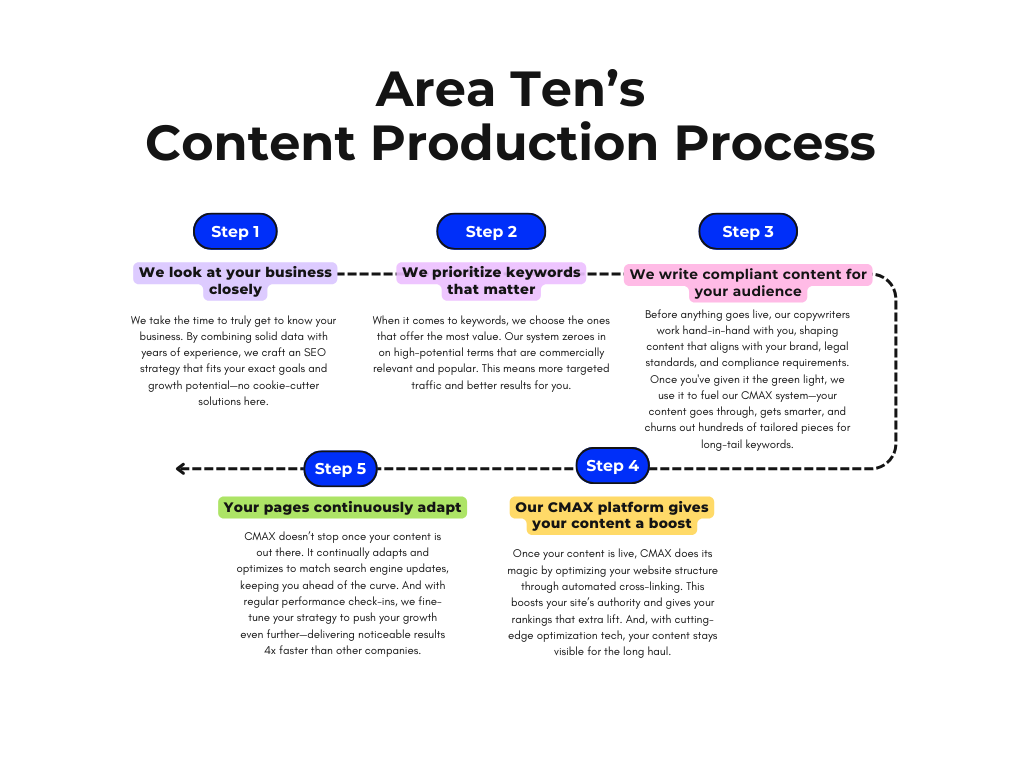
We kick things off by really getting to know your business inside and out.
Here, we combine smart data analysis with our years of experience to conduct SEO audits that’s a perfect fit for your unique goals and growth plans. Forget one-size-fits-all solutions; we dig deep to make sure everything is tailored specifically to your needs.
We take this initial step very seriously, as it sets the stage for a successful campaign from the very start.
Next, we prioritize keywords that hold the highest potential for your business.
Instead of just generating a long list of terms without any thought put into the process, we focus on terms that are both popular and commercially relevant. This ensures the traffic driven to your site is both substantial and suitable, with the ultimate goal being to boost conversion rates.
When it comes to content creation, our copywriters collaborate with you every step of the way.
We focus on making sure everything feels true to your brand, all while staying within legal and compliance guidelines. Once that’s all set, we run the content through our unique CMAX system, which helps target those niche long tail keywords that boost your content’s quality and reach.
This results in content that speaks directly to a wider, more specific audience, getting more people hooked on what your business has to offer.
Utilizing advanced technology, CMAX enhances your site’s authority by implementing smart cross-linking, boosting search rankings. Our cutting-edge optimization technology also ensures your content maintains high visibility over time.
By implementing our advanced programmatic SEO solutions, we make sure to amplify and sustain the effectiveness of your content pages.
The ever-changing ways of industry trends and Google algorithms are some of the biggest sources of headaches for SEO professionals. That’s why we’ve designed our CMAX system to continually adapt, allowing you to stay ahead in spite of these shifts. You’ll also benefit from weekly and real-time performance monitoring, allowing you to make improvements as soon as possible.
With our proactive approach and continuous adaptation, we can deliver results 4x faster than other companies and ensure ongoing SEO success for the long haul.
If you want to break free from stagnation, look no further.
Area Ten is the premier SEO agency based in Sydney, achieving 4x faster results at 10x the scale of traditional methods. With state-of-the-art programmatic SEO technology and industry veterans with over a decade of experience, we’re here to go above and beyond what your competitors are doing for unparalleled results.
Ready to take your SEO strategy to new heights? Inquire now!
Book a free video consultation below to see how your SEO & Paid Media campaigns are performing against global benchmarks in your industry.
We’ll uncover tangible opportunities to grow your business in just 6 weeks, including: